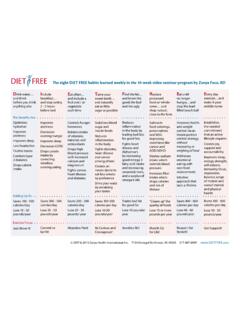Transcription of Philippine Agriculture Through the Years
1 Philippine Agriculture over the Years : Performance, Policies and Pitfalls 1. Cielito F. Habito and Roehlano M. Briones 2. Introduction Although many still think of the Philippines as an agricultural economy, strictly speaking, it is not. Agriculture , fishery and forestry directly account for just one-fifth (20. percent) of the economy's aggregate domestic output (GDP). Ever since the 1960s, the direct share of Agriculture in the GDP had fallen below one-third, and by 1981, the sector's share had decreased to only 23 percent.
2 Growth from this level was rather anemic, averaging percent per annum during the period 1981-2003, compared to the average overall GDP. growth of over the same period. While Agriculture output was largely stagnant Through the Years , industry and especially services significantly raised their output shares, particularly in the past two decades (Figure 1). Agriculture 's importance looms larger when it comes to employment, with nearly two-fifths ( 37 percent) of jobs currently coming from the sector. Still, the services sector accounts for close to half of both output and jobs in the economy.
3 But if one considers agro- processing and agricultural inputs manufacturing and trading ( agribusiness sectors) along with basic agricultural production, about 40 percent of GDP and two-thirds of jobs in the economy arise from Agriculture (Tolentino et al. 2001). Unfortunately, Agriculture also displays the most erratic growth among the economy's major sectors, with growth rates tending to fluctuate widely from quarter to quarter (Figure 2). The sector's recent growth performance manifests the same volatility. While the sector's full year real GDP growth performance was well within the target for 2004 and exceeded the preceding year's performance, the most recent quarters have seen dramatic slowdowns from previous quarters, due mostly to unfavorable weather conditions.
4 Notwithstanding these challenges, the critical role of the Agriculture sector in a country's overall economic development as stylized in economic development literature is well known. First, it provides food and vital raw materials for the rest of the economy. Second, it provides a significant market for the products of the non-agricultural economy, as buyer of farm inputs as well as consumer goods and services produced in the non-agricultural economy. And third, as the sector grows and modernizes in the face of limited supplies of 1.
5 Paper presented at the conference entitled Policies to Strengthen Productivity in the Philippines, sponsored by the Asia-Europe Meeting (ASEM) Trust Fund, Asian Institute of Management Policy Center, Foreign Investment Advisory Service, Philippines Institute of Development Studies and the World Bank, held in Makati City, June 27, 2005. 2. Professor of Economics and Director, Ateneo Center for Economic Research and Development, Ateneo de Manila University; and Senior Fellow, Brain Trust Inc. and Former Postdoctoral Fellow, World Fish Center, respectively.
6 Philippine Agriculture over the Years page 2 of 38. agricultural land, it releases surplus labor to the industry and services sectors. With 70. percent of the country's poor coming from the rural areas where Agriculture is the dominant source of livelihood and employment, the importance of Agriculture to the Philippine economy cannot be overemphasized. Thus, the Medium Term Philippine Development Plans (MTPDPs) of successive administrations have consistently recognized the critical importance of energizing and modernizing the agricultural sector in the overall pursuit of a vigorous and broad-based economic growth and development.
7 But as we discuss below, success with this goal has continued to be elusive. This paper reviews the trends in the Philippine agricultural sector's performance, and relates these to the policy environment within which the sector has operated Through the Years . The next section specifically examines the trends in production and productivity of the sector. The evolution of the policy environment that has influenced such performance is then reviewed in the following section. The last section identifies the pitfalls that have hampered investments in the sector and stifled growth in the agribusiness industry, and ends with a general indication of the needed interventions to overcome the sector's current hurdles.
8 Production and Productivity Trends Labor productivity. Up until the 1970s, the Philippines' agricultural performance, in terms of both agricultural Gross Value Added (GVA) and agricultural exports, compared well with its neighbors and other Asian countries (Figure 3a). But by the 1980s and 1990s, the country had lagged behind most of the countries in the region (Figures 3b and 3c). This came as agricultural output growth had slowed down dramatically Through the decades (Figure 4). Moreover, the sector's growth had been rather erratic in the 1990s, especially with the periodic occurrence of the El Ni o phenomenon that had appreciable impact on weather patterns and, consequently, agricultural performance.
9 Table 1 shows the average annual growth in GVA of major agricultural commodities since 1960. What is clear from the table is that growth rates of all commodities, except for livestock and poultry, have been slowing down over time. Furthermore, growth rates have been below the population growth rate, implying that production has not been able to keep up with increasing population. Erratic and decelerating growth over the past two decades is a major concern, as Agriculture continues to employ a large bulk of the country's poor.
10 Balisacan (2003). estimates that in 2000, the poverty incidence in Agriculture was 46 percent, the highest among the major sectors (with the exception of mining). It also contributed percent to population poverty, far exceeding the next biggest sectors (construction, at percent, and the unemployed, at percent). Employment in Agriculture has been stagnant, even as overall employment continues to grow at a rate of about percent per year from the 1990s onward (Figure 5). Hence, Philippine Agriculture over the Years page 3 of 38.















